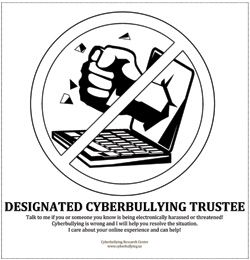Tips to Fight Back Against Cyberbullies

Brace yourself, parents. The bully has evolved. They don’t just throw punches or pull hair. They harass with text messages, streams of ridiculing instant messages, and fake Facebook accounts riddled with insults. How big is the problem? Alexis Pilkington, a 17-year-old soccer player from Long Island, hanged herself after schoolmates attacked her on Facebook and a question-and-answer social network site called FormSpringMe.com.
Though not every instance of online bullying ends in tragedy, the Cyberbullying Research Center found in 2010 that 1 in 5 students have experienced cyberbullying in their lifetime. And a Pew Internet Study on social networking showed that 32 percent of teens who use the Internet have experienced some form of online harassment—be it private material shared with others without permission (15%), a hurtful rumor spread online (13%), or harassment via cell phones (26%).
To help parents tackle this issue head-on, we spoke with three cyberbullying experts to provide the advice you’ll need to protect your child.
Meet the Experts
| Row 0 - Cell 0 | Row 0 - Cell 1 | Row 0 - Cell 2 |
| Nancy Willard, executive director, Center for Safe and Responsible Internet Use (www.cyberbully.org) Nancy Willard is a cyberbullying expert on issues of online behavior and effective Internet management in schools. | Parry Aftab, author, A Parent’s Guide to the Internet Parry Aftab serves as a consultant to Internet and digital technology companies and was featured in To Catch a Predator, written by Chris Hansen of the Dateline series. | Anne Collier, executive director, NetFamilyNews.org She co-chairs the Online Safety & Technology Working Group, which reported last year to the U.S. Congress on creating measures to increase online safety for children. |
Preventative Tips
Make good digital citizens.
Before your child takes the first plunge into socializing on the Internet, explain that the web is a public place—even when messages are sent via a “private” channel such as e-mail or instant message. Likewise, explain that sites that focus on open-air communications, such as Facebook and Twitter, may offer alternate, private ways to contact friends and family, but those messages can be forwarded or copy-and-pasted to anyone.
Stay in the know with Laptop Mag
Get our in-depth reviews, helpful tips, great deals, and the biggest news stories delivered to your inbox.
The same can be said for your-eyes-only e-mails and text messages. According to a 2007 study on cyberbullying by the Pew Research Center, the most prevalent form of online bullying is a private message shared with others against the commenter’s will.
Minimize the threat of this type of public embarrassment by reminding your child to be mindful of what they share, even with trusted friends and family.
Karma’s for the web, too.
For social networking and online etiquette, the popular saying “What goes around comes around” is as valuable as knowing when to use a frowning smiley or a winking one. When chatting, posting messages, or sending e-mails, it’s always a good idea for young web users to be “mindful of their digital footprint,” said Nancy Willard, director of the Center for Safe and Responsible Internet Use. In other words: “Don’t engage in unkind or hurtful actions online because the person you really hurt will be yourself.” That includes being the instigator of online spats as well as retaliating in them. Too much combative behavior could lead to a bad reputation online, and it could damage relationships with peers both in front of and away from the computer screen.
Encourage stronger password security.
No parent wants a stranger or potential bully to have access to their child’s Facebook account or e-mail address and all of the contacts within. Parry Aftab, author of A Parent’s Guide to the Internet, recommends teaching your kids “the importance of passwords, why they need to be protected, what can happen when they are stolen, and that passwords should be easy to remember, but hard to guess.”
Aftab and other experts also agree that the parents of burgeoning social networkers—such as 13-year-old teens who are newly eligible to sign up for Facebook—should always have their child’s password on file. “When young people first start using Facebook, it’s really important that parents pay very close attention,” said Willard.
Access doesn’t have to start with a password, either. Aftab advises parents to “say to your kids, ‘Your choice is to let me have your password or let me friend you—tell me what you want.’” Given the stigma of parents following their children on Facebook, it’s no surprise that many kids will opt to share their password.
Install monitoring software—even if you don’t use it.
Not every teenager is anxious to share his or her online experiences, even when an uncomfortable or harassing situation arises. So what’s a parent to do if a child isn’t forthcoming about online teasing or otherwise harmful digital circumstances?
“My attitude toward monitoring software,” Aftab said, “is that it depends on who your kids are. If they’re normal kids, they’re not at risk, or runaways, or abusing drugs, or emotionally-distant, install monitoring software such as Spector on every computer you own and never look at it, unless you need to. If they are at risk, then you’ll need it for sure.”
Software such as Spector ($69.95) keeps tally on all online activity—IP addresses, instant messages, e-mails, visited URLs, and keystrokes included. Other software options include Norton Online Family or online tools such as SafetyWeb ($10/month), SocialShield ($10/month), or AOL’s SafeSocial ($9.99/month).
Anne Collier, editor of cyberbully blog NetFamilyNews.org, agrees that monitoring software has its uses for tight-lipped teenagers, but she warns that parents need to be upfront about the software. “If you have an engaged parent, you’ve got some dialogue going. If not, you’re dealing with a total authoritarian parent and that doesn’t work in the online age.”
First Response

Don’t panic.
Finding out that your child may be a victim of online bullying can be emotional. Don’t let those emotions play into your pursuit of a solution. “The first thing to do is to remain calm,” said Collier, “because an overreacting, angry parent who just wants to stop her child’s pain can make things worse for the child.”
Because bullying, teasing, and taunting typically occur both online and off, it’s important for parents to remember that their response to the situation carries real-world repercussions for the child. Calling parents, school officials, local authorities, or flying off the handle without doing a little fact finding first could create more turmoil than is necessary.
Find out your child’s role.
When digital conflicts can ignite from something as small as a misdirected instant message, fake rumor, or misread joke, it can be hard to determine a clear instigator. Aftab suggests that, first and foremost, parents ask the child to explain his or her role in the fracas. “Parents are often indignant that someone has hurt their child, and they may not have realized that their child has hurt others,” she said. If your child inadvertently started the row, convincing him or her to apologize could vaporize the problem.
Ask who else was involved.
Is the bully attacking someone other than your child? Are multiple kids ganging up on her? A detailed list of aggressors, victims, and witnesses can inform your decision on how best to put a stop to the bullying.
Gather evidence.
It’s not a matter of whether you trust your child’s account. It’s a matter of proof. “Maybe he can show you the hate site or impostor profile or nasty e-mail or text message,” said Collier. “If not, a great thing to do is start gathering your own evidence—maybe it’s a screenshot or a copy-and-pasted conversation.”

Weighing Your Options
Block the aggressor.
Legal action isn’t always necessary. “Another approach is to ignore them and block the person,” said Willard. On Facebook and Twitter, blocking an unwanted friend or follower is simply a matter of adding the person to a special Block list. If you’re dealing with a bully who likes to call or text, you can block incoming messages from a certain phone number on many cell phones. Contact your carrier to find out how.
File a complaint.
If blocking doesn’t work, Willard suggests filing an abuse complaint with Facebook. Go to the aggressor’s profile and click the “Report/Block this Person” link that appears below the profile photo.
Call on a few witnesses.
“Witnesses play a very important role. They either stand by and encourage the harm, or support the person being harmed by standing with them and trying to resolve the situation,” said Willard. Helpful witnesses can join your child in filing abuse complaints against bullies and can even help have them ejected from Facebook.
Contacting the parents: Do’s and don’ts.
“When you approach a parent about cyberbullying, it is sometimes this amorphous thing that they see or read about in the media,” said Aftab. “They don’t really understand what cyberbullying is.” She also advises not to approach a parent and say “Your child did this horrible thing to my child.” You’ll likely wind up with a confrontation. That’s why Aftab advises caution when it comes to who you decide to approach, where you approach them, and how you approach them. Collier and Willard also recommend that you address parents calmly, show them the evidence, and refrain from getting defensive or upset.
Enlist school aid.
If you’re worried about a school’s ability to intercede in online bullying cases, don’t. “More and more schools absolutely have the authority to respond to off-campus speech if that speech has caused—or there are strong reasons to believe it will cause—substantial disruptions, such as violent altercations between students, classroom interruptions, or a significant interference with a student’s ability to receive an education,” said Willard.
Some pointers: Ask your child if they are comfortable involving school officials, then ask for recommendations on whom you should contact. There might be a teacher, guidance counselor, or other person your child feels comfortable involving in the situation.
Contact the authorities.
If a digital bully’s actions constitute criminal behavior such as violent threats, extortion, obscenity-filled or sexually charged language, or pornographic intent, get the local authorities involved.
If someone is posing as your child online, work with Facebook to have the fake page removed by going to the profile and selecting “Report/Block”. According to the social networking site, profiles that impersonate you or someone else, use your photos, list a fake name, do not represent a real person, or have been compromised are eligible to be shut down. If Facebook or another social network is too slow to respond, contact the police.
The Aftermath
15 Any child who has been victimized by a cyberbully will need some time to recover. Willard offers a few tips to facilitate that process. The most important steps: surround him or her in a network of adults and peers who can help reinforce a sense of self, and be sure to keep the child busy with extracurricular activities they’ll look forward to.
“Family, adult, and friend support, in addition to healthy activities and hobbies, are really important to help your child be more resilient,” emphasized Willard. “And the more resilient and secure your child feels, the less any bully will have to go on.”
Tools
Monitoring software such as SafeSocial, SafetyWeb, and Spector can help you keep tabs on your child’s online activities.
The Cyberbullying Research Center offers resources—such as this trustee poster—for parents and schools to help raise awareness and stop electronic harassment.
